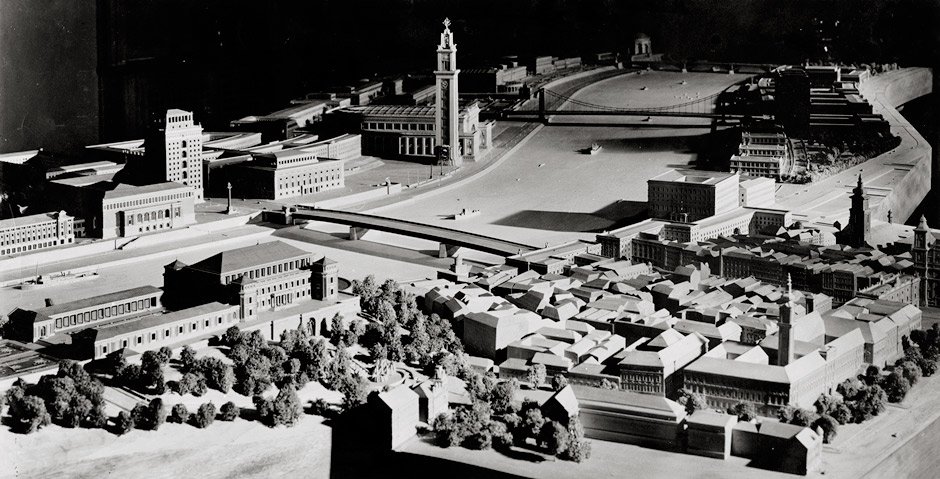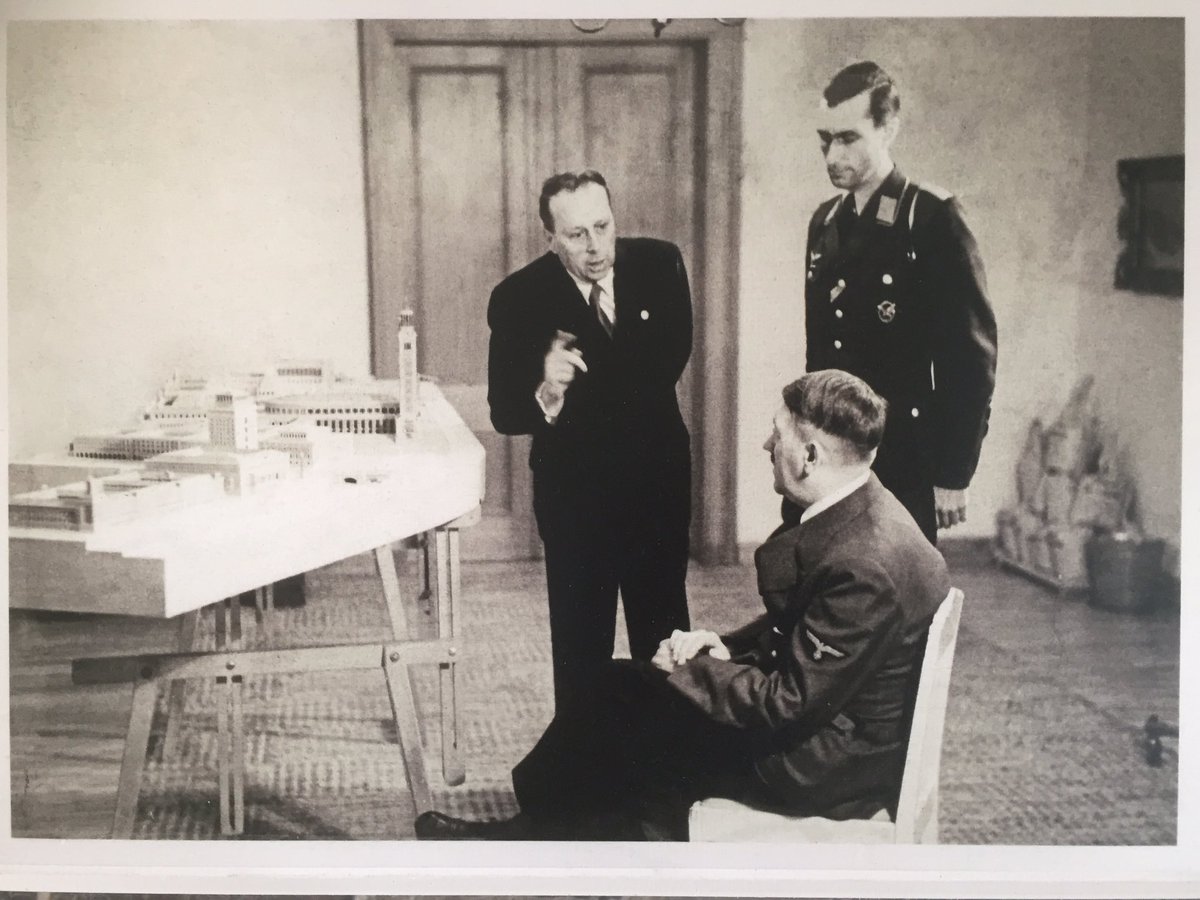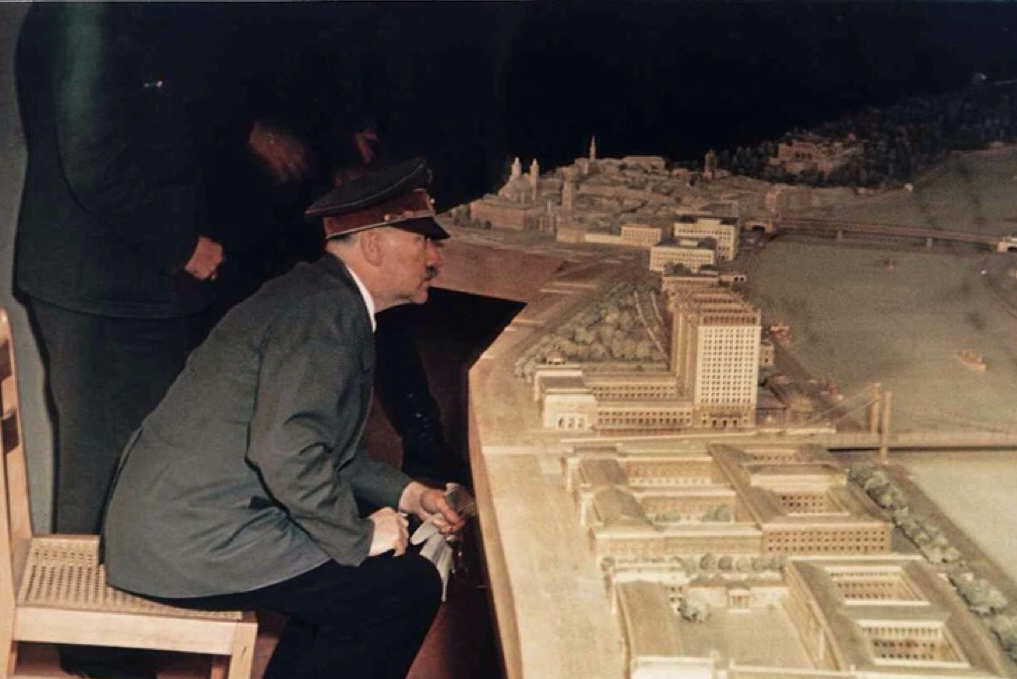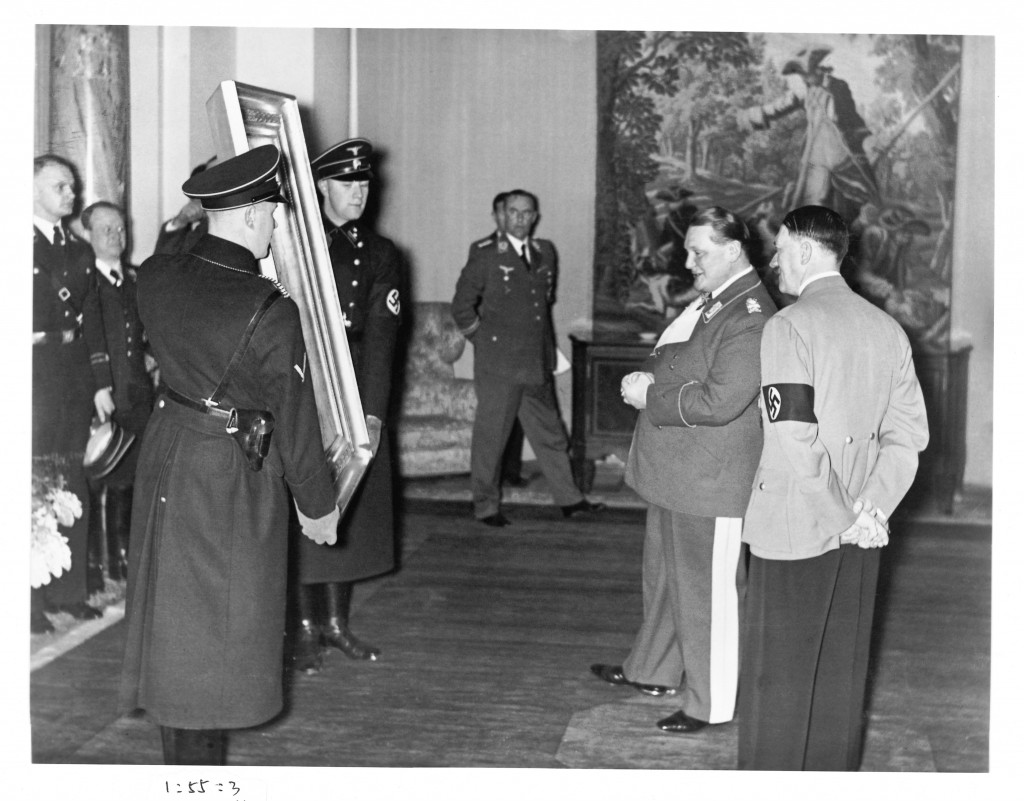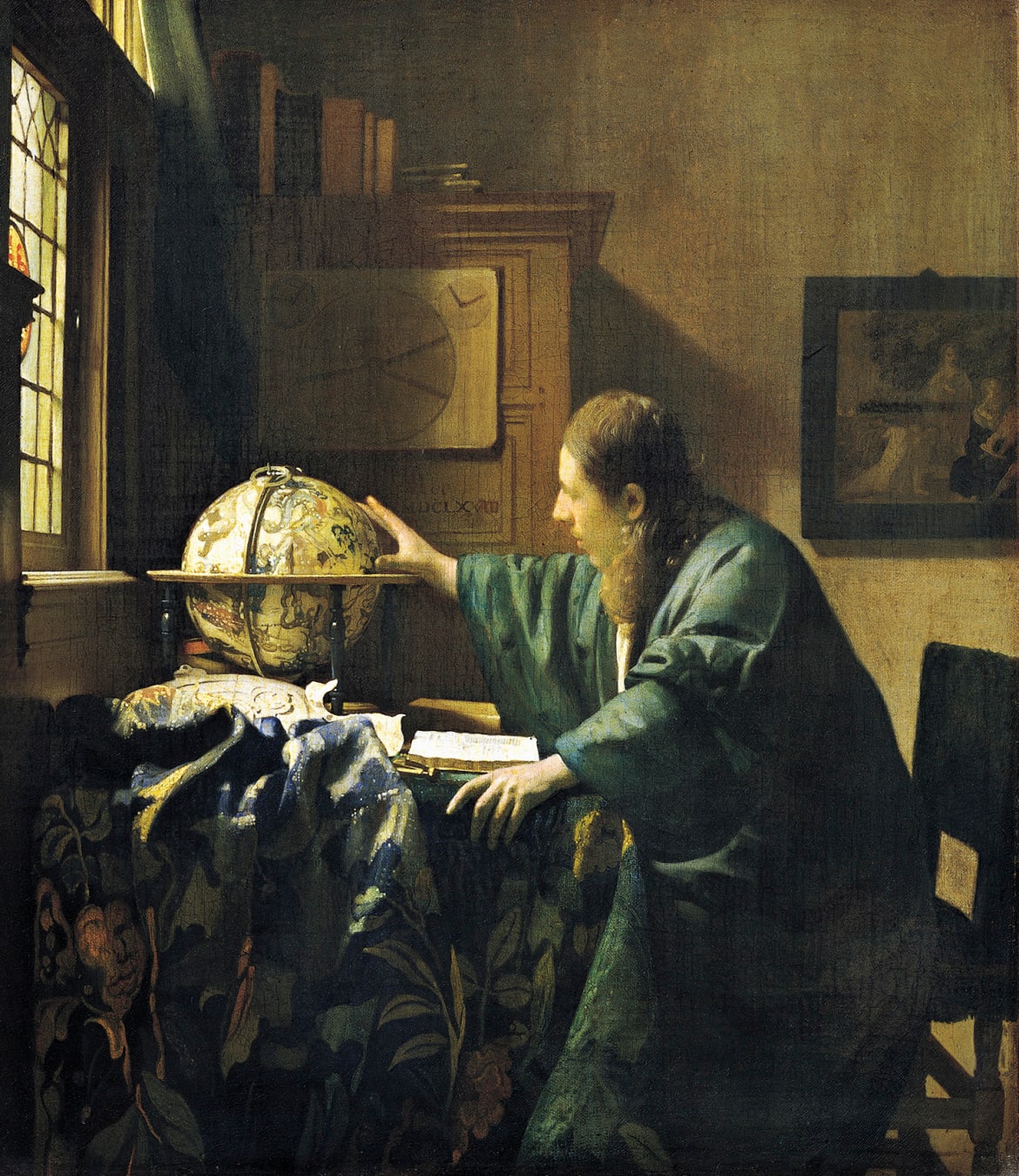Episode #26: Hitler's Führermuseum (Season 2, Episode 6)
One of the reasons that I decided to center this second season of the ArtCurious Podcast around art and World War Two is that there are so many different stories that we can tell about how art and war intersect-- especially and most critically during this war to end all wars. As I discussed in episode #21, the first of the season, it may seem on the surface that there aren’t many direct correlations between World War Two and the arts, but in fact, there were many very tangible connections-- and you can even say that there were physical connections between the two as well. Because while the lives of millions were in the balance during the run of the war, so were those of the visual arts as well. Thousands of paintings, sculptures, drawings and prints, once safely ensconced in homes or collections, were suddenly uprooted at the whim of one man, with one very particular museum in mind for them. Today, we’re digging into the story behind one of the most significant museums never built-- Hitler’s Führermuseum-- and was it really going to be as great as it purported to be?
// Please SUBSCRIBE and REVIEW our show on iTunes.
Episode Credits
Production and Editing by Kaboonki Creative. Theme music by Alex Davis. Research assistance by Stephanie Pryor. Social media assistance by Emily Crockett.
Additional music credits: "Lädschad" by Dee Yan-Kee is licensed under BY-NC-SA 4.0; "La brise" by Circus Marcus is licensed under BY-NC 3.0; "Arrival" by Misha Dioxin is licensed under BY 4.0; "Rise" by Kyle Preston is licensed under BY-NC 4.0; "The Signals" by Sergey Cheremisinov is licensed under BY-NC 4.0
ArtCurious is sponsored by Anchorlight, an interdisciplinary creative space, founded with the intent of fostering artists, designers, and craftspeople at varying stages of their development. Home to artist studios, residency opportunities, and exhibition space Anchorlight encourages mentorship and the cross-pollination of skills among creatives in the Triangle.
Recommended Reading
Please note that ArtCurious is a participant in the Bookshop.org Affiliate Program, an affiliate advertising program designed to provide a means for sites to earn advertising fees by advertising and linking to bookshop.org. This is all done at no cost to you, and serves as a means to help our show and independent bookstores. Click on the list below and thank you for your purchases!
Links and Further Resources
Daily Beast: Inside Hitler's Fantasy Museum
Episode Transcript
One of the reasons that I decided to center this second season of the ArtCurious Podcast around art and World War Two is that there are so many different stories that we can tell about how art and war intersect-- especially and most critically during this war to end all wars. As I discussed in episode #21, the first of the season, it may seem on the surface that there aren’t many direct correlations between World War Two and the arts, but in fact, there were many very tangible connections-- and you can even say that there were physical connections between the two as well. Because while the lives of millions were in the balance during the run of the war, so were those of the visual arts as well. Thousands of paintings, sculptures, drawings and prints, once safely ensconced in homes or collections, were suddenly uprooted at the whim of one man, with one very particular museum in mind for them.
Some people think that visual art is dry, boring, lifeless. But the stories behind those can be paintings, sculptures, drawings and photographs are weirder, crazier, or more fun than you can imagine. And today, we’re digging into the story behind one of the most significant museums never built-- Hitler’s Führermuseum-- and was it really going to be as great as it purported to be? Welcome to the ArtCurious Podcast, exploring the unexpected, the slightly odd, and the strangely wonderful in Art History. I'm Jennifer Dasal.
If you’ve just joined us for this second season of the ArtCurious Podcast-- welcome, first and foremost. And next, I would also recommend that you pause this episode and go back and listen to the second in this season-- number 22, about Adolf Hitler’s artistic aspirations in his youth. Having that information at your disposal will be helpful in understanding why, perhaps, the concept of his Führermuseum, or Leader’s Museum, was so important to him. But certainly, it’s also probably enough to know these things about Hitler: that the arts--and visual art in particular-- had always resonated with him, as did his romantic vision of an artist’s lifestyle. But his failure to enter the Academy of Fine Arts Vienna in the early 20th century crushed his dreams of becoming a world-famous creator. If he couldn’t be an artist, though, he could still find a connection in the arts by becoming a voracious collector. And once Hitler began amassing money after the First World War, he eagerly sought out to become just that.
In terms of personal taste, Hitler’s collection preferences were particularly Germanic-- specifically homing in on nineteenth-century landscapes and peasant-centered genre paintings from southern Germany, especially Munich and its surroundings. He was also drawn to the heroism and strength of Classical Greco-Roman design, and loved the romantics as well as the german realists, being especially keen on works by artists like Hans Thoma, Adolph von Menzel, and Arnold Böcklin. What he didn’t like was anything modern-- and really, really didn’t like anything with overt religious overtones, either. But from most accounts, it looks like he was attempting to get beyond his own personal preferences and looking far ahead to the future-- and to his legacy.
According to Frederic Spotts in his 2002 book, Hitler and the Power of Aesthetics, it seems that the soon-to-be dictator had already been dreaming of putting together a so-called “German National Gallery” in Berlin, and had even already casted the role of museum director in his mind: and that director was to be Hitler himself. I mean, really, he had this whole thing planned out. By 1925, he was already sketching structures in his notebooks, until he had dreamt up a two-winged building, featuring a total of 60 rooms for the display of art, and even delineated where his favorite artists and paintings would be located. Redeveloping his plan a few years later, however, brought him to an interesting dilemma. Berlin by that point was already known as a cultural hot spot, having five museums in the city center beginning in the 1830s and progressing over the following century. Museum Island, as it would become known, was already jam-packed with artistic treasures, including the Altes Nationalgalerie, which already housed a trove of nineteenth century masterworks. Hitler’s German National Gallery might end up seeming redundant in this context.
But there was another reason, too. By 1933, Adolf Hitler had been appointed chancellor and he was dedicated to his single-minded intention to make Germany both a single-political party country and the greatest country in the world. And as the leader of the greatest country in the world, he assumed that would make HIM the greatest person in the world, right? And so, with that ego-stroking concept in mind, Hitler refocused the geography of his German National Gallery entirely back towards himself-- meaning that his hometown of Linz, in Austria, now seemed like the perfect place to celebrate his artistic and political greatness. This connection proved to be even easier to make after the Anschluss, or annexation of Austria, in 1938, where Linz, like all of the country, fell under German control.
That same year, though, the real concept and direction of Hitler’s grand museum came into place clearly and concisely. He undertook an official state visit to Italy-- specifically to Rome, Florence, and finally to Naples, and while he was in each location, he performed the requisite duty of any good tourist and was treated to sightseeing tours in each location-- and treated to special banquets and honors by Mussolini and King Vittorio Emmanuele, of course. As even visitors today to Italy will know, the art to be found there is really and truly astounding. And in 1938, Hitler felt the same way-- and yet, his thoughts were also tinged with not a little bit of jealousy. It was at that time that he decided that his gallery wouldn’t be just any other gallery, and certainly not just a Germanic one. Instead, the Linz gallery would become the greatest art museum in Europe-- nay, the greatest art museum in the world.
According to Frederic Spotts, Hitler consistently and unfailingly spoke of his dream-- which was referred to both as the Linz Museum and as the Führermuseum, or the Leader’s Museum-- by both Hitler and his closest advisers. His secretary noted that it was a frequent subject of conversation, not only among his highest-ranking officials, but also for visitors who attended his regular afternoon teas. And he personally thought of every detail-- even down to how much space was to be found between paintings in any given gallery. He even designed his own plans for the building, which he handed over to architect Roderich Fick to bring to full fruition. By 1940, when Fick was assigned to the project, Hitler had expanded his original drawings from a two-winged structure to a four-winged one in order to house double the artwork. Remember: it was no longer supposed to be the greatest museum in the German empire, but in the entire world. And even if the collection of European art began to grow even more, both Fick and Hitler brainstormed ways to include additional structures within Linz to house even more works of art. Indeed, the Führermuseum was the most important part of Hitler’s concept for his renovated hometown, but it wasn’t the only one. Linz was to become the cultural center of the continent-- not only housing the famed art museum, but also, and I quote, “a new City Hall, new Nazi Party headquarters, a new railway station, a stadium, a community hall, a technical university, an institute of metallurgy, a planetarium, a suspension bridge, and two new towers, one of them with a carillon and a mausoleum for Hitler's parents.” Unquote. And of course that wasn’t all-- those are just the highlights. Century-old spoiler alert: none of these things was actually ever built, with the exception of one: the Nibelungen Bridge over the Danube River, which is still in existence today.
Hitler’s insistence on being the mastermind of the greatest art collection in all the world meant that he had to get his hands on the greatest artworks in the whole world-- which to him, naturally meant only Western, or Eurocentric artworks. The original core of the permanent collection of the Fuhrermuseum was meant to be Hitler’s own personal collection-- his beloved stores of 19th century Germanic painting. But that wouldn’t go very far to establishing such a grand amassment of works, and Hitler himself was far too busy to go about sourcing whatever was available on the art market. So he commanded a lawyer named Heinrich Heim to make trips to Italy and France, then the art capitals of Europe, to do some shopping for him. Heim himself had some expertise and familiarity with fine paintings, prints, and drawings, so he wasn’t an entirely random pick. He was armed with a considerable amount of money from three of Hitler’s financial endeavors: the sales of his autobiography, Mein Kampf, real estate ventures, and from the royalties he received after allowing his visage to be used on postage stamps. This totaled nearly 100 million Deutschmarks, which allowed Heim to make some pretty significant purchases. But the problem here is that this really only limited Heim, and thereby Hitler, to works that were already available for sale. So what do you do when you really want the best in the world but you can’t actually buy it? I think that you probably already know the answer. And that’s coming up, after the break.
Do you want to help support this show? Not only can you donate to us on our website, but you can also benefit from a special offer. For listeners of this show, Audible is offering a free audiobook download with a free 30-day trial to give you the opportunity to check out their awesome service. Two books that are currently fascinating me are Broad Strokes: 15 Women Who Made Art and Made History (in That Order) by Bridget Quinn, and The Art of Rivalry: Four Friendships, Betrayals, and Breakthroughs in Modern Art by Sebastian Smee. You can find these, as well as the biggest bestsellers like Turtles All The Way Down by John Green, or What Happened by Hillary Rodham Clinton-- and thousands more. And for every free trial, the ArtCurious Podcast gets a little kickback-- which is so incredibly appreciated. To download your free audiobook today go to audibletrial.com/artcurious. Again, that's audibletrial.com/artcurious for your free audiobook.
Welcome back to ArtCurious. Even while Adolf Hitler terrorized the world in the midst of World War Two towards his goal of creating a unified and quote-unquote “purified” Germany, he was equally engaged in another more private goal: the establishment of the greatest art museum in the world: the Führermuseum, which would simultaneously act to glorify himself as leader. But there was an issue of adding the world’s best works to his collection. There was that teeny, tiny, niggling problem of… the works belonging to other individuals and institutions. But Hitler had a plan for this. As part of the invasion and annexation of various European countries in the midst of World War Two, Hitler declared viciously that any artworks seized in the process-- whether from museums or private collections-- would become part of his personal collection with the end goal of the very best items being placed on display at the Fuhrermuseum. These holdings were known as the Fuhrer-Reserve, and allowed Hitler that continued personal control over his dream project. Items of lesser value that were seized along the way could end up in the offices or homes of other officials or in smaller institutions, but the creation of the Fuhrer-Reserve assured Hitler would get first pick. But just as with Hitler’s assertion that Heinrich Heim would personally handle any art purchases, Hitler also needed someone to manage the seizure of artworks as well. So, in June of 1939, he formed the Sonderauftrag Linz or the Linz Special Commission, and named Dr. Hans Posse as the commissioner. On June 26th, Hitler signed an official degree with his intentions, writing, quote, “ I commission Dr. Hans Posse, Director of Dresden Gallery, to build up the new art museum for Linz. All Party and State services are ordered to assist Dr. Posse in fulfillment of his mission.” Unquote. Hans Posse’s own artistic specialties, in the more than twenty years he spent as the director of Dresden’s Art Gallery, focused on French, Italian and Dutch paintings, with additional interest in early German works as well. To Hitler, this was ideal-- particularly since he himself wasn’t a collector of those fields of work and had little knowledge of them. He could then trust that Posse would be able to build up the collection of the Linz museum with the assistance of various other scholars: including ethically-dubious art dealers, additional painting and print curators, experts in arms and armor, in coins, and even a librarian and a curator of books.
Though it probably doesn’t need to be made explicit, I’m going to say it anyway. Much of what Hans Posse did, under Hitler’s demands, was allow the outright theft of precious works of art from anyone that any SS officer came across. And those officers really could forcibly steal any item that they wanted, and do it in any way necessary-- this included killing the rightful owner of the artwork or item. Hitler declared the seizure of any quote-unquote “ownerless” works of art, but what exactly constituted an “ownerless” work could really be justified in any number of ways, including whether or not an officer considered someone worthy of even owning a work of art. In the case of Jewish individuals, this was particularly the case, as they would be swept aside to concentration camps-- or worse-- while their heirlooms were raided and the Fuhrer-Reserve grew considerably and proportionately. As the war progressed, Posse began noting that the Linz collection was becoming increasingly valuable, with masterworks by Leonardo da Vinci, Raphael, Tintoretto, Hans Holbein, Anthony van Dyck, and Rembrandt, as just a few examples of the spoils of war from Poland, Austria, the Netherlands, Czechoslovakia, and elsewhere.
Interestingly, this belief about the predominance of stolen versus purchased works in the Linz repositories is still a debated topic today-- something which came as a bit of a surprise to me when I began researching this episode. Some experts have noted that only about 12 to 15 percent of the Linz works were stolen or received via a so-called forced sale; but others have argued that even works that were actually outright purchased by Posse and his team were essentially looted by false pretenses, because dealers in occupied countries were paid for any sales in Reichsmarks, which was practically worthless due to massive inflation at the end stages of World War II. In addition, Hitler’s art crew wheeled and dealed hard when it came to art sales. Their offers were bargain-basement, at best. As Gerard Aalders, a Dutch historian, noted, quote, "If Hitler's or Göring's art agent stood on your doorstep and offered $10,000 for the painting instead of the $100,000 it was really worth, it was pretty hard to refuse." Unquote.
Aalders’s mention of Goering brings up another confusing facet in the business of Hitler’s art collection. Hermann Göring, one of the top leaders of the Nazi Party and the second-most powerful man in Germany under Hitler, frequently enacted directives to the Einsatzstab Reichsleiter Rosenberg, a mouthful thankfully abbreviated to ERR, or the organization dedicated to the appropriation of cultural property and headed by Alfred Rosenberg, the prime Nazi philosopher. Fundamentally, visual art would fall under the umbrella of cultural property, so even without direct link to Posse and his acquisitions, Rosenberg was gaining art for Hitler through the ERR, too. But Rosenberg himself had little interest in cultural property as anything more than an idea or a symbol-- but Hermann Göring did. All accounts note that Göring's interest in art, tapestries, jewels, furs, and fine housewares was nearly as unquenchable as Adolf Hitler’s, and so under the auspices of the ERR, thousands of items ended up in Göring's own coffers. As writer Robert Edsel reported, this sometimes would put Göring in a bind, because his own wants could come into conflict with those of Hitler’s. Göring, though, he was smart about it, and knew that if Hitler wanted a specific sculpture, Hitler better well have it, and Göring would not hesitate to step down. He’d even sweeten the deal on occasion to appease the Fuhrer, offering presents from his own collection in the name of the Linz Museum-- including the Vermeer painting, The Astronomer, which was confiscated from the Rothschild collection in France and which subsequently became Hitler’s very favorite among all the Linz-destined properties.
All the while, Hans Posse was still hard at work as the director of Hitler’s top-secret Führermuseum, and he toiled in this position for more than three years, until his death from cancer in December of 1942-- and in that three years, he brought together more than 2500 individual works of art specifically for the Führermuseum.
Hans Posse’s death didn’t at all slow down Hitler’s vast dreams for Linz as the cultural capital of the world. Just three months later, in early March of 1943, Hermann Voss, an art historian and museum director in Berlin, took over as the special commissioner for the Linz project. Frederic Spotts notes in his book that this initially appeared to be a rather strange appointment on Hitler’s part, as Voss was someone who was not only highly friendly with German Jews, but was also fairly anti-Nazi himself. But, as with Hans Posse before him, he was also a scholar of French, Italian, and German painting-- so Spotts suggests that Hitler ultimately cared more about Voss’s knowledge than his political leanings and hired him anyway. If that is true, then it is yet another revealing fact about how much art truly mattered to Hitler-- so much that he was able to somehow turn a blind eye towards a man who would otherwise be considered his political enemy.
The acquisitions for the Linz cultural institutions were ongoing throughout the war. Posse, and Voss after him, made a habit of presenting works of art to Hitler himself for special anniversaries-- especially for Hitler’s own birthday, which was a mandated state holiday ever since his 50th birthday in 1939. When too many purchases-- and I’m using that word in air quotes, naturally-- were made to easily bring them personally to Hitler, the Linz team created photo albums documenting the future museum’s assets, and those albums would become presents in and of themselves, offered to the leader on his birthday, and on Christmas, through the end of 1944. In total, 31 volumes of these albums existed, but only 19 have been located today. The remaining albums may be lingering out there in some musty attic, or perhaps they were destroyed, or are simply lost from the ravages of war.
Towards the end of World War Two, something peculiar happened. Hitler and his compatriots began slowly realizing that they were on the losing side-- and that defeat was coming, surely and swiftly. So In the last few months of the war, he began dwelling even more on his obsession with his hometown, as it symbolized everything he wanted in one clean package: fame, glory, history, culture, purity. In response to his faltering dreams, he pestered those in charge of the various Linz projects to put together a large scale model of the entire cultural complex. On February 9, 1945, it was declared ready for his review, and Hitler, along with close advisers and his official photographer, who recorded the event, studied the miniature city in detail. As Ian Kershaw wrote in his book, Hitler: 1936-45: Nemesis, quote, “Bent over the model, Hitler viewed it from all angles, and in different kinds of lighting. He asked for a seat. He checked the proportions of the different buildings. He asked about the details of the bridges. He studied the model for a long time, apparently lost in thought. ...Looking down on the model of a city which, he knew, would never be built, Hitler could fall in reverie, revisiting the fantasies of his youth, when he would dream...about rebuilding Linz.”
Adolf Hitler committed suicide on April 30, 1945, and in the wake of his death and the Allies’ victory, it was nearly impossible to determine the full amount of works of art that were seized and set aside specifically for the Führermuseum in Linz. However, Frederic Spotts and other historians have estimated that somewhere between 7,000 to 8 thousand five hundred works of art were probable additions. Of course we’re lucky that the Axis Powers lost the war and weren’t able to increase this number of potential acquisitions, but it’s also good to put it into context. Let’s take France’s Louvre museum as an example, as it is typically listed as the largest museum in the world by both square footage and by collection size. Today, the Louvre owns approximately 380,000 objects and displays about 35,000 works at any given time. If the Linz complex ended up with a total number of 8500 objects, as historians have estimated, that would mean that it, essentially, would only have been a little over two percent as large as the Louvre. What this breaks down to is that Hitler’s hope of creating the grandest museum in the world wasn’t even remotely close to rivaling its geographic neighbors. Not even a little bit. What’s more is that simply in terms of an overview of Western art, the Führermuseum had some ridiculous holes. Again, using Spotts as my reference point, he notes that there were major gaps in English, Spanish, and Northern Renaissance art, as well as some significant artists lacking from the Italian Renaissance and Baroque collections. Okay, okay, I can guess that some of you may be grumbling, because this is me playing a big game of “what if” based on incongruous things: the reality of the works earmarked for the Linz museum vs. what may have added if the Axis powers had won the war and gained even more works of art. I’m probably also comparing apples to oranges when it comes to the number of works currently in the Louvre versus what they were nearly 100 years ago- though surely it is somewhat comparable. Regardless, the bottom line is that Hitler’s dream for the FuhrerMuseum may have been big, but the reality certainly didn’t match up to it.
Next time on the ArtCurious Podcast we’re revisiting one of our most popular episodes, which documents one very specific instance of Nazi art looting in the former Soviet Union-- and attempts to answer a question about one of the most famous artwork disappearances of all time. Subscribe now, and don’t miss it.
Thank you for listening to this episode of the ArtCurious Podcast. This episode was written, produced, and narrated by me, Jennifer Dasal. Our new theme music is by Alex Davis at alexdavismusic.com. Research assistance is by Stephanie Pryor, and social media help by Emily Crockett. Our production and editorial services are provided by Kaboonki Creative. Video. Content. Ideas. Learn more at kaboonki.com
The ArtCurious Podcast is sponsored primarily by Anchorlight. Anchorlight is an interdisciplinary creative space, founded to foster artists, designers, and craftspeople at varying stages of their development. Home to studios, residency opportunities, and exhibition spaces, Anchorlight encourages mentorship and the cross-pollination of skills among creatives in the Triangle. please visit Anchorlightraleigh.com.
The ArtCurious Podcast is also fiscally sponsored by VAE Raleigh, a 501c3 nonprofit creativity incubator. This means that you can donate to the show and it is fully tax-deductible! Please see our website for further details-- and you can also go there for images, information and links to our previous episodes. That site is artcuriouspodcast.com. And you can contact us via the website, email us at artcuriouspodcast@gmail.com, or find us on Facebook, Twitter and Instagram at artcuriouspod. --and remember to subscribe and review us on iTunes. Check back in two weeks as we continue to explore the unexpected, the slightly odd, and the strangely wonderful in art history of the World War Two Era.





